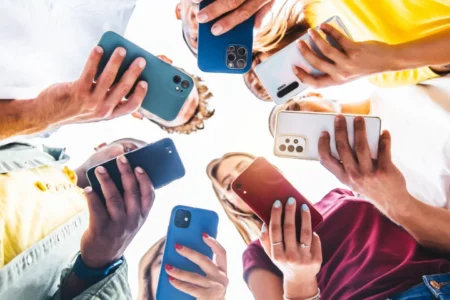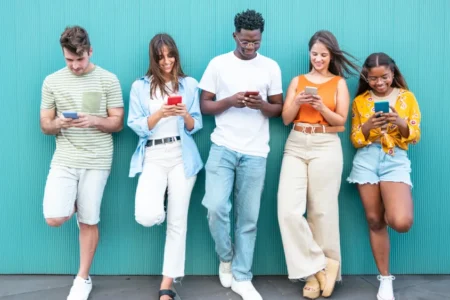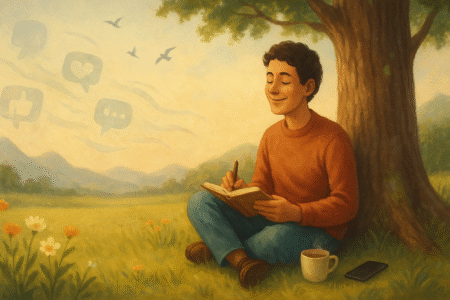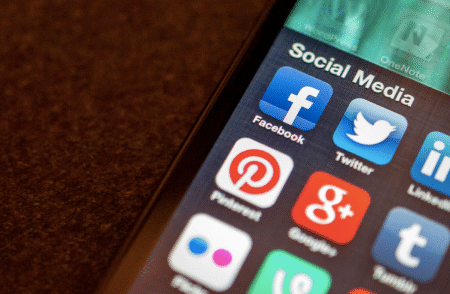Gen Z isn’t just cancelling “good vibes only” — they’re rebuilding the straight-talk language of mental health, one painfully honest post at a time. Gone are the days of self-care defined as cucumber slices on eyes and candlelit baths. Now, it means cancelling toxic friendships, learning how to say no without guilt, prioritizing therapy over brunch in the budget, and deleting the app and getting off-line when it’s too much on-line. “We don’t want pretty. We want real,” says Aanya Bhattacharya, 20, an artist in Kolkata, India, who regularly posts her raw sketches about anxiety attacks and intrusive thoughts – without filter or font overlay. “My mental health doesn’t have an aesthetic. It has triggers and scars.” What’s Actually Working?Therapy-Tok & Unfiltered Talk: Creators are defining new ground by going beyond self-care tips and openly discussing trauma bonds, emotional regulation, generational baggage and strategies for CBT. Accounts run by a licensed therapist and psychology students are gaining traction, not on gimmicks, but on grounded and relatable advice. Meaningful Memes: Surprisingly, one of the most effective vehicles of this movement? Memes. From “crippling anxiety starter packs” to “trauma response bingo,” dark humor is empowering Gen Z to express what they have been taught to suppress. And it’s working – because sometimes laughing at the pain helps you process it. So What Now? The future of Gen Z’s mental health revolution is not to stop using digital tools – it’s to use them thoughtfully. Therapists as influencers. Content-creating mental health professionals are increasingly becoming important bridges from awareness to action. Be it TikTok skits or Instagram infographics, their presence adds a level of expertise to the conversation. Offline support circles. Gen Z is starting to learn that healing does not always need to happen in public. Support groups, therapy pods, community care meet ups, and “venting clubs” are becoming more and more popular as safe offline avenues to express their emotions. As this generation of WiFi-native anxiety sufferers goes forth, they are creating something never seen in the world before: a mental health culture that is messy, honest, compassionate – and most importantly human. Keep reading Foramz for your daily dose of Moral support.
The Beginning: From Hashtags to Honesty, Gen Z is calling out the glossy nature of mental health awareness Gen Z is taking action, saying “stop” to the pastel-fueled quotes proclaiming that every problem can be solved with a “just smile through it” attitude. The phrase “Mental health is not a trend” is starting to be spread across platforms such as TikTok, X (Twitter), and Instagram, where users (mostly aged 18-25) are calling out what they perceive to be toxic positivity disguised as wellness advocacy. Individual accounts that started as a couple of viral videos calling out “good vibes only” have morphed into a digital rebellion, bringing attention to these mental health trends. Okay, but what is Toxic Positivity? Toxic positivity is defined as a form of overgeneralization of a happy, optimistic state in which one denies, minimizes, and invalidates emotions that are unavoidably a part of the human experience. “Every time I ever said I was anxious or depressed- people would just say, ‘don’t worry, be happy!’ Like.. bro, that’s not therapy, that’s denial,” said 19-year-old Priya Kapoor, a psychology student from Pune, in a trending Instagram reel. The Internet Is Ironic: Likes Versus Lives The issue, as many people see it, is the Instagrammification of mental health. Bath bombs, aesthetic mood boards, and journal prompts are now ubiquitous—but therapy bills? Systemic issues? Trauma? Not so much. Issue critics argue that all these online trends related to mental health and wellness are dangerous in their oversimplifications. “If someone posts a selfie crying with #MentalHealthAwareness but never mentions therapy, coping strategies, or any real emotion, what are we actually doing?” says Sana Rizvi, a 21-year-old sociology major. But Gen Z isn’t just calling out the improprieties—they’re reclaiming the conversation. Across platforms, hashtags such as #MentalHealthIsNotAesthetic, #StopToxicPositivity, and #ItsOkayToNotbeOkay have begun to trend. Videos mocking overly positive “self-help influencers” have gone viral—not to ridicule the wellness industry, but to demand authenticity. This new movement of online content doesn’t shy away from dark days, breakdowns, or emotional messiness. Rather, it emphasizes vulnerability as strength. Many young creators now share their healing journeys as open diaries— with therapy, medication, community care, and boundaries at the forefront. To Be Continued in Part 2: Gen Z’s Mental Health Revolution — What’s Working, What’s Not, and Where We Go From Here… KEEP READING FORAMZ.COM FOR MORE UPDATES
In the last blog, we talked about a new emerging disorder, which is digital Dementia. Digital Dementia is the phenomenon where the increased screen time and constant connectivity play a grave role in affecting a person’s health. In an era that is dominated by screens, notifications, and constant connectivity, Digital Dementia has emerged as a silent yet pressing cognitive health concern. Coined by neuroscientists to describe the cognitive decline, particularly in memory, attention, and concentration, caused by over-reliance on digital devices, digital dementia is no longer limited to the elderly or the tech-obsessed. It is now affecting young adults, teenagers, and even children. But the good news is that digital dementia can be undone. The term coined by neuroscientists to describe the significant decline, particularly in memory, attention, and concentration, caused by over-reliance on digital devices, digital dementia is no longer limited to the elderly, the poor the tech-obsessed. It’s now affecting young adults, teenagers, and even children. Let us have a look at how effectively we can get rid of the newly emerged digital dementia issue. It is possible to rewire our brains for better focus, memory, and overall cognitive resilience. Let’s explore some practical, science-backed solutions to combat this modern-day mental drain. Digital Detox: The First Step to Recovery One of the most effective ways to overcome the problem of Digital dementia is simply reducing screen time. By reducing your screen time, you can get rid of the blue light, which is harmful to your eyes, back, and brain’s growth. It might feel overwhelming to just stop using the phone all of a sudden, but you can start small. Set daily limits on smartphone use. Designate “no screen” zones at home, especially the bedroom and dining areas. You can even take regular breaks using the 20-20-20 rule: every 20 minutes, look at something 20 feet away for every 20 minutes, look at something 20 feet away for 20 seconds. If you are someone who works online, scheduling short, structured digital detents over weekends or during vacations can dramatically improve your brain function, creativity, and emotional well-being. Think of it as giving your brain time to breathe. Start with Memory Training and Brain Exercises Our brains are like muscles- they get stronger with use. With smartphones acting as our external memory drives 9think saved passwords, reminders, GPS directions), we have stopped exercising our natural memory skills. To feel in charge of your brain and get active, it is crucial to reclaim these abilities. Start with brain-training exercises such as: Memorizing phone numbers or grocery lists, Playing cognitive games like Sudoku, chess puzzles, and reading a page of your favourite novel. Practicing mental math instead of reaching for a calculator also signifies brain activity. Engaging in these activities improves neuroplasticity—the brain’s ability to form and reorganize synaptic connections—effectively reversing some effects of digital dementia. 3. Read Physical Books and Write by Hand Book Readers are preferring to read books in PDF format to save the hassle of purchasing books from different vendors and shops. Reading books in print rather than on a screen promotes deep reading and comprehension-something skimming articles online does not offer. Writing things down by hand, whether journaling, note-taking, or sketching, activates areas of he brain responsible for learning and retention. Studies show that people who write things down manually remember information better than those who type it. So, the next time you need to remember a task or an event, ditch the notes app and pick up a diary. 4. Mindfulness and Meditation Mindfulness practices are powerful tools for strengthening attention and memory. Just 10 minutes of daily meditation can improve focus, reduce anxiety, and even reshape brain regions responsible for cognitive control. Practicing mindful breathing, where you focus on your breath and gently bring your attention back when your mind wanders. This simple habit can train your brain to be more present and less distracted. 5. Physical Exercise and Outdoor Activities Exercise regularly improves blood circulation to the brain, lifts mood, and aids memory. Walking, yoga, or dance not only activate the body but also get the brain to disconnect from screen overstimulation. Spending time outdoors has the additional advantage of sensory diversity—something the brain desires but lacks in repetitive digital life. Nature walks, gardening, or even sports can improve concentration and mental acuity. 6. Social Interaction and Real-Life Conversations Over-dependence on digital communication can lead to social withdrawal and emotional fatigueon digital communication can lead to social withdrawal and emotional fatigue. Rebuilding real-world connections through face-to-face conversations, community events, or simple daily interactions helps stimulate emotional intelligence, empathy, and memory. Talking, listening, and engaging with others offline gives the brain the challenge and stimulation it needs to stay agile. Digital dementia is the issue of the modern age, it is not a life sentence. It is a wake-up call. It reflects how modern convenience can come at a cognitive cost- but also how simple conscious choices can help us reclaim our focus, memory, and mental balance. By integrating digital discipline with real-world cognitive practices, we can future-proof our brains and stay sharp in a world that never sleeps. Keep Reading Foramz for your daily dose of moral support.
Social Media is an increasing concern in today’s world. With increased influencers, brand deals, and dopamine kicks, social media proves to be a hazard to teenagers’ health. The Indian Parliamentary panel has been struggling to find a solution to this issue. In a recent turn of events on May 6th, the Parliamentary Standing Committee on Communications and Information Technology wrote to the Ministry of Electronics and IT and the Ministry of Information and Broadcasting. After the Pahalgam terror attack, a parliamentary panel has asked the government to furnish details on the action it plans to take against social media platforms and influencers who seem to be working against the interest of the country, which is likely to incite violence.” The Parliamentary Standing Committee on Communications and Information Technology wrote to the secretary, Ministry of Electronics and IT, and the secretary, Ministry of Information and Broadcasting, seeking these details. The office memorandum from the panel, say sources, requested the ministries for details of ‘contemplated action taken to ban such platforms under IT Act 2000 and Information Technology (Intermediary Guidelines and Digital Media Ethics Code) Rules, 2021’. The sources said that the panel has sought this information by May 8, 2025. BJP MP Mr. Nishkant Dubey headed to the parliament’s Standing Committee on Communications and Information Technology. There have been as many as 26 people who were killed in the April 22 Pahalgam terror attack, and there has been a rise in cross-border hostility between India and Pakistan after the incident. X handles of several Pakistani political leaders, including Defence Minister Khawaja Asif, Minister Abdullah Tarar, former Prime Minister Imran Khan, and former minister Bilawal Bhutto, have been withheld in India as tensions between the two nations remain high. Several FIRs were filed against social media users over their comments about the Pahalgam terrorist attack. Security agencies across the country remain on high alert as tensions escalate between the two nations following the attack. Accusing Pakistan of fostering cross-border terrorism, India has announced a series of punitive measures, including cancelling visas for Pakistani nationals, closing the border and airspace, downsizing diplomatic missions, suspending trade, and putting the Indus Waters Treaty under review, among other steps. Keep Reading Foramz for more news




